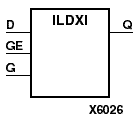
ILDXI
Transparent Input Data Latch (Asynchronous Preset)
XC3000
| XC4000E
| XC4000X
| XC5200
| XC9000
| Spartan
| SpartanXL
| Virtex
|
|---|
N/A
| Macro
| Macro
| N/A
| N/A
| Macro
| Macro
| Macro
|

ILDXI is a transparent data latch, which can hold transient data entering a chip. When the gate input (G) is High, data on the input (D) appears on the output (Q). Data on the D input during the High-to-Low G transition is stored in the latch.
The latch is asynchronously preset, output High, when power is applied. FPGAs simulate power-on when global set/reset (GSR) is active. GSR (XC4000, Spartans) default to active-High but can be inverted by adding an inverter in front of the GSR input of the STARTUP symbol.
ILDXIs and IFDXIs
The ILDXI is actually the input flip-flop master latch. Two different outputs can be accessed from the input flip-flop: one that responds to the level of the clock signal and another that responds to an edge of the clock signal. When using both outputs from the same input flip-flop, a transparent High latch (ILDXI) corresponds to a falling edge-triggered flip-flop (IFDXI_1). Similarly, a transparent Low latch (ILDXI_1) corresponds to a rising edge-triggered flip-flop (IFDXI). Refer to the following figure for legal IFDXI, IFDXI_1, ILDXI, and ILDXI_1 combinations.
Inputs
| Outputs
|
|---|
GE
| G
| D
| Q
|
|---|
0
| X
| X
| No Chg
|
1
| 0
| X
| No Chg
|
1
| 1
| 1
| 1
|
1
| 1
| 0
| 0
|
1
| 
| D
| d
|
d = state of referenced input one setup time prior to High-to-Low gate transition
|

